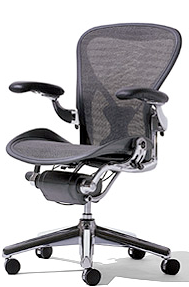Design Classics
Aeron Chair, 1994
Designer: Don Chadwick, Bill Stumpf
Manufacturer: Herman Miller

For industrial designers Don Chadwick and Bill Stumpf, a chair is as much about science as it is about art. When the team was commissioned to design a new office task chair, they engaged ergonomists those people who study the efficiency of the body in the work space as well as orthopedic specialists and physical therapists. Their quest was to understand every aspect of how people sit in and use chairs. They monitored pressure points, calculated weight distribution and measured heat dissipation.
WHAT
The result of their research was a new kind of chair and it took the design world and the business world by storm. To accommodate all shapes and statures, the Aeron is available in three sizes. A virtual cockpit of controls allows for further personal adjustments. Most surprising it isn't upholstered. Traditional foam and fabric are replaced with transparent form-fitting and breathable polyester mesh that distributes the body's weight. But it's the signature shape that truly differentiates the Aeron chair. As Mr. Stumpf said, the human form has no straight lines ... so we designed the chair to be biomorphic, or curvilinear, as a metaphor of the human form. There isn't one straight line to be found on an Aeron chair.
WHEN
Herman Miller introduced the Aeron chair in 1992. Initial reaction was mixed. Some thought it looked too odd, too technical and too faddish. Not surprising, considering many high-end office chairs sported tufted leather upholstery and wooden bases. Since then, many of the Aeron's ergonomic and design innovations have become commonplace.
WHY
The launch of the Aeron chair reflected a new approach to the office and to the nature of work. Its groundbreaking design asked, and answered, the question if work and workers are changing because of technology, shouldn't the accoutrements of work change as well? What started as the chair of choice for hip technology, design and media companies soon became ubiquitous in law firms and banks who wanted to proclaim their participation in the new economy. By the end of the century, the Industrial Designers Society of America and Business Week magazine declared the Aeron chair the Design of the Decade. The irony is that after the dot-com meltdown, slightly used Aeron chairs flooded the used-furniture market.
National Post, November 10, 2005.
